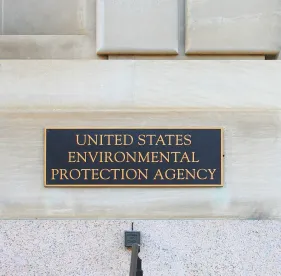Yesterday, on June 1, the U.S. Environmental Protection Agency (EPA) Administrator, Andrew Wheeler, signed a final rule seeking to increase predictability for applicants by clarifying the regulations that govern the Clean Water Act (CWA) Section 401 water quality certification process.
As discussed in earlier blog posts, certain states have relied on ambiguities in the CWA Section 401 water quality certification process to block the construction of significant energy infrastructure projects (e.g., oil and gas pipelines, coal export facilities, and liquid natural gas terminals) determined by federal agencies to be in the public interest of individual states, regions, and the nation as a whole. For example, on May 15, the New York State Department of Environmental Conservation (DEC) denied a CWA section 401 water quality certification associated with the construction and operation of an interstate natural gas pipeline. The denial was based, in part, on DEC findings associated with greenhouse gas (GHG) emissions and New York’s recently-enacted Climate Leadership and Community Protection Act, which requires a 40 percent reduction in statewide GHG emissions from 1990 levels by 2030 (and an 85 percent reduction by 2050), and 100 percent of New York’s electricity generated by carbon-free energy by 2040.
CWA Section 401 requires applicants for a federal license or permit anticipated to result in discharges to navigable waters to obtain a certification from the relevant state that the discharge will comply with applicable state water quality standards. States can waive this requirement, and if they do not act within “a reasonable period of time (which shall not exceed one year) after receipt” of the request for the certification, waiver is automatic. 33 U.S.C. § 1341(a). Contrary to this plain language, projects have been derailed or significantly delayed when states exceed the statutory one-year time limit for certification or deny certification for reasons unrelated to water quality, such as a project’s potential downstream GHG emissions.
EPA’s existing regulations were promulgated in 1971 and pre-date the 1972 CWA amendments. In accordance with Executive Order 13868, which directed EPA to clarify the certification process and revise its outdated regulations, yesterday, EPA Administrator Andrew Wheeler signed the pre-publication version of the final rule.
Key Aspects of EPA’s Final Rule
Our October 31, 2019 blog post, provided an overview of EPA’s proposal to revise and update its CWA Section 401 regulations. Although the final rule is very similar to the proposal, it includes a number of key changes. Key aspects of the final rule and changes that EPA made since the proposal are included below:
-
The time period for state review begins with receipt of a “certification request”—a term defined by the proposed rule—and not when a state deems the request valid or complete.
-
Change from Proposal: A project proponent must submit a pre-filing meeting request to the state at least 30 days prior to submitting its certification request. EPA intends to promote early coordination before triggering the start of the reasonable period of time for review.
-
-
This time period does not pause or stop for any reason once the state has received the certification request.
-
The CWA does not guarantee that a state or tribe may take a full year to act on a request for certification; a state must act within a reasonable period of time (which may be established by the federal permitting authority on a case-specific basis). What this means is that each federal agency may establish a unique time period for the state water quality review associated with the federal permit or license, which may be less than one year.
-
If the state does not act within the established reasonable timeframe, federal permitting agencies may determine that the certification requirement has been waived and issue the federal permit or license.
-
The scope of the state’s review and the scope of the certification is limited to assuring that the “discharge” from the permitted activity will comply with water quality requirements, an analysis that does not include matters unrelated to water quality (e.g., GHG emissions, transportation impacts, etc.) or consideration of other aspects of the applicant’s activity as a whole.
-
To condition certification, a state must explain why the condition is necessary to assure compliance with water quality requirements, and cite the federal or state law that authorizes the condition.
-
Change from Proposal: EPA had proposed to require states to include a statement of whether and to what extent a less stringent condition could satisfy applicable water quality requirements. EPA decided not to include that provision in the final rule.
-
To deny certification, a state must identify the specific water quality requirement with which the project will not comply, explain why the proposed project will not comply and specify what data are needed to assure the discharge would comply.
-
Federal permitting agencies can find that a state has waived its certification authority or waived its authority with regard to a specific condition if the state does not include the necessary rationale.
-
Change from Proposal: The final rule does not authorize federal agencies to substantively review certification conditions or certification denials to determine whether they are within the appropriate scope of certification or whether the rationale is sufficient. Federal agency review is now limited to whether states have complied with the procedural requirements in the final rule.
-
Change from Proposal: Under EPA’s proposal, there were complex procedures to allow the state to remedy deficiencies in certification conditions or denials. Under the final rule, such conditions or denials will be deemed waived by the federal licensing or permitting agency.
New Water Quality Certification Process
Under the final rule, the water quality certification process would follow the sequence outlined in the flow chart, below.
Click image to view larger.
The rule will go into effect 60 days after the date of publication in the Federal Register and will likely draw legal challenges from certain states and environmental groups who oppose the rule. The final CWA Section 401 water quality certification rule is another wrinkle in the evolving CWA regulatory landscape, adding to other recent developments, for example, the County of Maui U.S. Supreme Court opinion in County of Maui and the final Navigable Waters Protection Rule.





 />i
/>i


